Arrival to La Paz Airport, transfer your accommodation and check in. Free day to relax and take it easy, maybe explore a little this high city.
Note: La Paz is really high so it is best to do everything slow the first days. Drink a lot of water, eat light, avoid alcohol and don´t rush!



In Southern South America you will definitely need to stay connected via WhatsApp.
Travel with the affordable e-SIM. It allows you to use maps for navigation, communicate with tour and transfer services via WhatsApp, and keep in touch with friends and family.
Find a suitable data plan here: https://wyse.celitech.com/?REFID=WYSEMHIT100925
At 8 am, Tiwanaku Day Trip
After 1 hour and a half ride you will reach this pre Columbian ruins, surrounded by beautiful nature. The ancient city and culture of Tiwanacu is supposed to be one of the most important in the American continent. It is believed that they were even more advanced in pottery, astronomy and math than the neighboring Incas. If you are traveling further north you will see Tiwanacu influence in the archaeological sites of Peru. After a visit to the uncovered ruins (there is a lot that is being uncovered but is not open to the public), the tour returns to La Paz and will leave you at you hostel or hotel at about 4 pm. You will be amazed to learn how this ancient people used to live and what they believed, so different from us nowadays.



Free day in La Paz to visit the old town.
Check out, go on your own to the bus station to take the bus to Copacabana, a small town at the shores of Lake Titicaca. After 3 hours ride, arrival to town and check in.
At 2.30 pm, you will go for a light hike to Kasanani Hill, beautiful and ancient astronomical observation site built by the Incas to follow the movement of the sun and the moon and calculate eclypses and follow the change of seasons. 200 m from there you will find the Intikala temple, or Stone of the Sun, a series of big seats carved in stone. Then you will visit the Cathedral of the Virgen de Copacabana, that holds inside the image of the Holy Mary carved by an Inka in 1583. After that, you will reach the summit of the hill so see great views of the Titicaca lake and surroundings. Back to hotel and dinner.



At 8 am you will take a boat to the northern part of the Isla del Sol, arriving at 10.30 am to the comunity of Challapampa. You will visit the Gold Museum and then you will walk for half an hour to the Inca Chincana Ruins, to later reach the Table of Stone. Along the island many archaeological sites can be seen with one highlight: the Sacred Rock or the Rock of the Origins where according to the legend, Manco Capac and Mama Occlo departed to stablish the city of Cusco later on. At mid day, back to the Port to have lunch.
At 2 pm you will board the boat to begin the trip to the south of the island, stopping at Yumani port to see the boats made of "totora" (cattail in english). From the port, you will hike up to the village of Yumani at the south end of the Isla del Sol, passing by a series of inca ruins and 3 sacred springs of water. Yumani is an aymara comunity that built its town on top of an inca site with streets and walls made of stone. At the summit you will see the sunset, back to hotel and dinner.



After breakfast, walk down to the port through another route to pass by the ruins of the palace of Polkokaina and the Temple of the Sun. Back to Copacabana at 11.30 am with time to catch the bus to La Paz, that will depart at about 14.30 hs (ticket will be waiting for you at the Copacabana ticket office) The bus to La Paz takes about 3 hours, so you will have time between 17.30 and 20 to 21 hs to go walking or eating, meantime you can leave your bags at a luggage store in the bus station. From La Paz you will take an overnight bus to Uyuni town. Please try to use whatsapp during the trip as some tickets and important information are shared this way in Bolivia.



Day 1 of the Overland Uyuni to San Pedro
Morning arrival to Uyuni from la Paz. Wait at a cafe before the Overland begins. At about 10 am, departure to the village of Colchani, the entrance of the most beautiful salt flat in the world (and the biggest and the highest! ) . You will board the Jeep 4WD you are going to use until the end of the overland and meet your driver and other staff. They almost don´t speak English and even their Spanish is basic but are normally very friendly and helpful. This is the beginning of the real adventure.
Salt flat crossing to be amazed by the feeling and the colours of the "out of this planet " landscape.
The driver has to drive slowly and you will have plenty of time to relax, enjoy and be amazed by this wonder. You will never forget this day.
In the end of the day you will get to a Salt Hostel to spend the night. Salt Hostel means that the walls and some beds are built with salt bricks.
Note: the itinerary can be changed en route if the driver sees any change in weather conditons or in the roads or any reason they judge the itinerary needs to be different. But the atractions keep the same
**Important note**: The Bolivian High Plateau, also known as the Puna, is a remote region with limited services, scarce water, no electricity in many areas, and a local culture very different from what most travelers may be used to. The landscapes are breathtaking, and the journey is unforgettable — but the itinerary is subject to change at any time due to weather conditions, road closures, or limited availability of accommodations. Schedules are flexible, food is simple (not gourmet), and both the altitude and the vehicles can be uncomfortable. The salt flats may be flooded, requiring alternate routes.
If you're approaching this trip with expectations of punctuality, comfort, and polished service, you might not enjoy it. But if you come with an open mind, understanding the limitations of the region and its people, you'll likely have the adventure of a lifetime — and take home some of your best travel memories.



Day 2 of the Overland Uyuni to San Pedro
After the night by the salt flat, the tours heads towards the desert and the High Plateau also called Puna or Altiplano. In the morning you will see how the landscape is changing while you climb higher and higher and in the afternoon you will go past the Siloli desert, where the wind and sun and rain carved strange volcanic rock formations. By lunch time you will probably be at Laguna Escondida (Hidden Lagoon, also called Laguna Negra), but itinerary can change. Finally, you will arrive to Laguna Colorada, where more than 30.000 flamingoes nest every year. Arrival at the comunal hostel and dinner. The communal hostels are very basic but clean and a part of the Altiplanic experience. Night can be in Huayllajara or Porques.
San Pedro to Uyuni Overland Tour
To read before travelling.
This San Pedro to Uyuni overland is a true adventure, one you won´t forget. But if you are looking for a comfortable air conditioned seat, smooth paved roads, swiss punctuality and perfect information in your mother language, you may re think your destination.
The landscapes are incredible and unique but also extreme and rough.
People with high blood pressure and heart conditions should check with the doctor before coming.
The altitude reached is 4.900 meters above sea level. The lack of oxygen may affect people in some way or another. You need to be prepared to follow some advices to reduce the effect of altitude to the minimum, in order to enjoy the trip. Ref the age, it is not a matter of years but attitude and some minimum fitness.
In the extreme conditions of dirt and stone roads, things can go wrong: a flat tire, a cable burned, a broken battery, so schedules may need to be changed. Drivers have the experience to take you safely to destination but be open to changes in times, accommodation and meals places.
Although it is a desertic high plateau, it can rain and conditions in roads and in the salt flat can change rapidly, so again changes must be expected.
Drivers and other staff in Bolivia have not the education you have. They almost don´t speak English and Spanish is their second language. They speak quechua. Don’t expect a lot of information and communication. But they really know what they do. They look for you, adapt to changing situations, give advices when sick, prepare the food, book accommodation, look for the best times to be at destinations, and generally speaking, always try to help you to have an unforgettable time. Comparing to this, their different education is just another color of the adventure and the cultural immersion.
Accommodation standards: Close to the salt flat, accommodation is in a Salt Hostel or Salt Hotel. Close to the Lagoons and Avaroa National Park accommodation is a communal hostel taken care by village families. Basic but clean and comfortable enough to rest and continue the adventure.
Some useful tips for the overland:
If you are taking the trip from San Pedro to Uyuni, get some Bolivianos before the trip, you will need to pay entrances to National Parks and they only receive national currency. You may change at the entrance of the park but the exchange rate will be horrible.
Bring toilet paper or fresh baby towels with you, toilets are available only in specific places along the road, usually they don´t have paper. In the desert: “inca toilets”!
The night before the beginning of the trip, try to avoid smoking, red meat and alcohol. The 1st day of the San Pedro trip or the 3rd day of the Uyuni – San Pedro direction, the cars get to an altitude of 4.900 meters. During the trip try to eat light and drink a lot of water to help your body to adapt to thin air. If despite the preparation you get “soroche” or “apunamiento”, don´t panic. It can be uncomfortable but your body will finally adapt. Common symptoms are headache, dizziness, nausea, and bad humor. Think positively, do everything slowly, breath calmly and drink lots of water. It is a good idea to buy some “soroche” pills before the beginning of the overland. If you don’t need them maybe a travel companion does!
If you are coming from La Paz or from San Pedro (and visited high places like the Tatio Geisers) your body may be already adapted to altitude and you will feel less its effects.
Try to avoid the last seats. You will end up switching with your companions but be aware that the last seats vibrate more and affect you more.
Accomodation is basic but clean and comfortable. A hot shower costs 10 Bolivianos so mind this money (less than 2 USD) if you want to refresh from dirt road.
Bring clothes for 30 degrees Celcius and 0 degrees Celcius the same day! Depending when you are travelling, weather can be extremely unpredictable. It is normally hot but in the rainy season (DEC-FEB a bit of MAR) storms can appear suddenly. Also take into account that every 180 meters, the temperature reduces 1 degree. Do the math and calculate the temperature when you are between 3.500 m and 4.900 m. So pack your swim suite along with good boots, polar clothes and a good jacket. Use the onion layers technique to adapt to ever changing temperature.
Plus: Bring sunscreen, sunglasses, trekking shoes, a hat and again enough water (Note: calculate how much water you will really drink, many people carry big bottles of 6 liters of water and it may be too much and uncomfortable)
Day 3 of the Overland Uyuni to San Pedro
You will be picked up at the hostel between 4.30 and 5 to be able to dive deeper (or higher!) into the desert and the Puna. The vehicle will ride along deserted landscapes, climbing higher and higher without even noticing it is happening. You will see lagoons with plenty of wild life (White and green lagoons), huge white topped mountains and volcanoes, and altiplanic plains while you talk to your companions and learn about their travels. First part of the day takes you to Sol de Mañana Geysers. Breakfast is provided at a place of hot springs and after that, you'll get to the border Hito Cajon where you'll take a minivan to San Pedro de Atacama. Around midday, check in and free day in San Pedro de Atacama
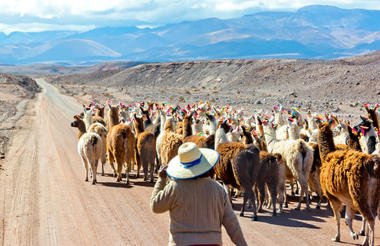
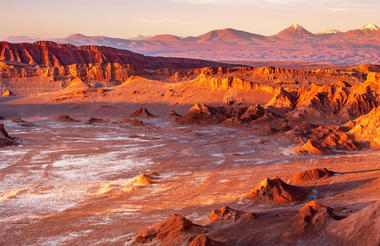
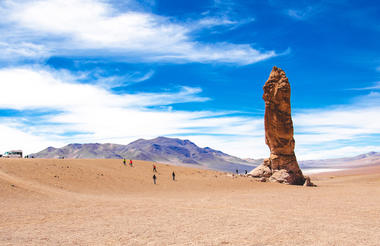
Free day to relax or to visit valle de la Luna
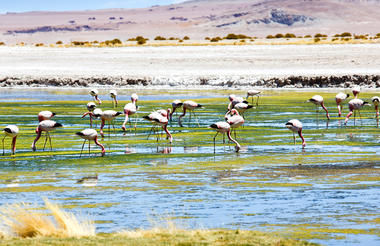
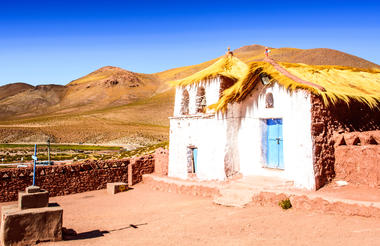
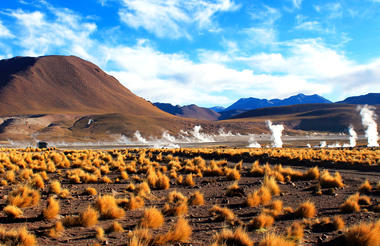
Geysers del Tatio Excursion: You will be picked up at the hostel between 4.30 and 5 am depending on season to be able to admire the driest and highest desert in the world. The road will take you between hills and mountains of the tough Andes range until you reach the geothermal site of the Geysers, 1 hour and a half after departure. There you will be able to admire the out of this world Geysers, fumaroles and steaming craters that show the volcanic activity of the region. The Geysers reserve is located at 89 km from San Pedro and 4.230 meters above sea level. So temperature is low in summer (-6 degrees Celcius) and even colder in winter (july-august) (-20 degrees Celcius). It is very important to take warm clothes and plenty of water to help your body adapt to such a high altitude. Breakfast is offered viewing the geothermic field and on the way back there is a short stop at Machuca Village. Back to San Pedro hostel at about mid day



Check out, go to the bus station to take the bus to Salta. After a long and very interesting ride, arrival in Salta in the afternoon. Find your own way to the hostel. Check in and free evening
Note: bus between San Pedro de Atacama and Salta does not run on Sundays



Cafayate and Villages Day Tour
We are leaving from Salta to the South, taking the route 68, passing through little towns like Cerrillos, La Merced, El Carril, Cnel. Moldes, La Viña (agricultural area which main production is tobacco). We are passing by the village of Alemanía, and from there we are entering to Cafayate Gorge (Quebrada de las Conchas), where we´ll see in the mountains the erosion of millions of years, created by wind and water (Devil´s Throat, Amphitheater, The Monk, The Castles, Parrot´s House, The Windows and The Toad). After visiting these places, we are arriving to the town of Cafayate to visit a winery and to taste the specialty of the region, torrontés wine. After walking through the town, we are coming back to Salta through the same gorge, which will offer us a different landscape in our way back to the city.
Departure time: 7:30 to 7.50 (there can be variations depending on location of accommodation)
Departure Point: any hotel or hostel in Salta Downtown. Note: there are hotels and hostels away from the city center so before booking please check if the bus reaches the place.
Arrival Point: any hotel or hostel in Salta Downtown
Duration: 10 hours
Frequency: Daily departures. Blackout 25 dec and 1 jan. Guaranteed departures
Transport: Mini-Bus (19 or 24 pax)
No age limit



Cafayate and Villages Day Tour
- Bilingual Guide (English – Spanish)
- Transportation
- Entrances to National or Provincial Parks
- Lunch
Check out, go on your own to the bus station to take the night bus to Resistencia.
Arrival to Resistencia and change bus to reach Puerto Iguazu. Arrival and transfer to your accommodation



Breakfast. At about 7.45 hs, to be reconfirmed by local guides: Excursion to the Falls, Argentine side (Full Day):
Pick up at accommodation. This Tour will take you to visit part of the Iguazú National Park, that preserves 67.000 ha. of giant trees, vines and ferns living with multicolored butterflies, birds and mammals, all part of the rich local flora and fauna.
The park was declared Natural World Heritage in 1984, due to its scenic beauties and the great biological diversity of the subtropical jungle. The famous falls are in the heart of this Park.
You will start the visit at the Local Museum and continue the tour along the Lower Trail, from where you can see the "Two sisters Falls", the "Bossetti Fall", the "Hidden Fall", a panoramic view of "San Martin island" and the "Union Fall".
Later you will walk the Upper Trail shifting along walkways located above major falls up to the majestic "San Martin Fall” from where you have a panoramic view of the Brazilian falls.
Finally, you go with the Train of the Jungle up to "Devil's Throat" station. From there, after a 1,000 meters walk along the catwalks, you will reach the spectacular "Devil's Throat", where the Iguazu river expresses itself with all its strength and the falling water gives the illusion of magic rainbows. You will be transferred back to accommodation
Note: national park entrance fee is not included



Breakfast. At about 7.45 hs, to be reconfirmed by local guide. Excursion to the Falls Brazilian Side, half day:
Pick up from accommodation. The guide will take you to visit the wonderful Iguazu Falls, on the Brazilian side, from where you can enjoy a panoramic view of the Argentine side, perfect for taking the perfect picture you could not take when you were in the other side.
You will get close to "Floriano", "Deodoro" and "Benjamin" waterfalls and the walkways lead you also to "Santa Maria Falls." It is a short but stunning tour. After the tour, if you are hungry, the guides will offer a stop in a Brazilian all you can eat restaurant. It will depend on your budget but it is quite a good value for money and it is your chance to try Brazilian dishes! You will be transferde back to accommodation.
Note: national park entrance fee is not included



Morning
Check out, transfer to Foz do Iguacu bus station (Rodoviaria) to take the night bus to Rio.
Arrival in Rio de Janeiro and go on your own to your accommodation. Check in and free rest of day.
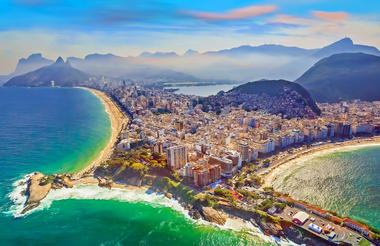
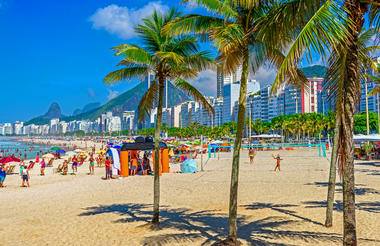
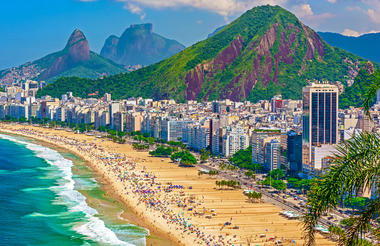
Breakfast. At 8 am, Big Dude Rio de Janeiro Full Day Tour. All of Rio de Janeiro best sights in just one packed day. Details:
From 8:00 am to 08:30 am: Hotel pick-up by mini-bus
11:00 am Stop at São Conrado to watch the hang gliders land on the beach.
11:30 am Stop at Tijuca Forest for a walk around the park to experience a real rainforest.
12:15 pm Drive through the Tijuca Forest towards Christ the Redeemer.
12:40 pm Stop at Christ Statue for a visit to the top (ticket included).
14:15 pm Drive to Santa Teresa for a lunch break (not included), followed by a walk around the neighborhood
15:30 pm Drive to Lapa for a visit to the colorful steps “Escadaria Selaron”, made famous by Snoop Dog in his music video “Beautiful”.
16:30 Drive back to hotel with the option of a drop-off at Sugarloaf



Breakfast. Free day to enjoy Rio, the beaches or to take a day tour to Buzios or Angra dos Reis



Check out, transfer to the airport. End of adventure!








